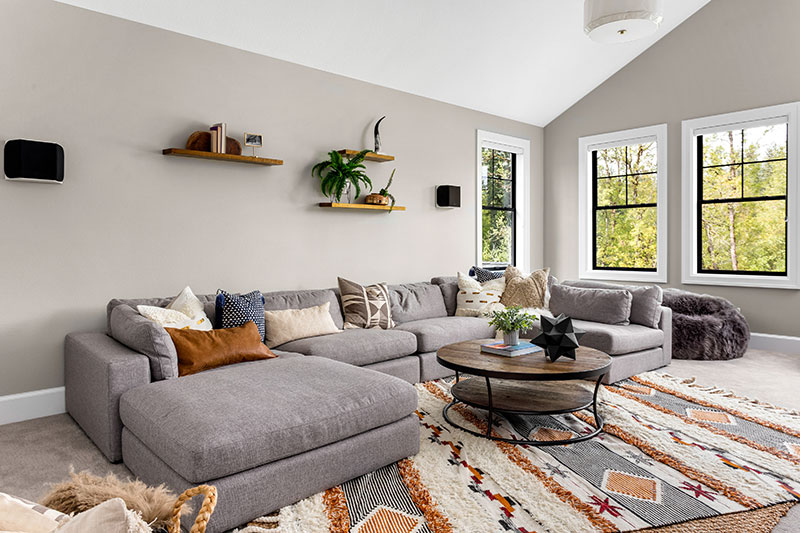Advertisement
What variables add to a living room’s attractiveness and cohesion? Many interior design practitioners and experts believe that there are a variety of factors at play to avoid unintentionally turning a certain living space into a stuffy and messy area.
Consider the following living room design tips and ideas if you want to create a comfortable, cohesive, and appealing environment in your house that you and your family can spend time in.
1. Finish The Walls And Ceilings
Due to the public character of the space, living room walls have historically been more elaborate or formal than those of other rooms. Utilize wallcoverings or window treatments that suit your unique style to create a warm and inviting place reflective of your individuality. You can either use wallpapers or paints depending on what living room style you want to achieve. Once done, you can finish off your walls with stunning framed art pieces.
2. Experiment With Various Textures
It’s easy to overlook texture when designing a living space, especially when we don’t see it as much as touch it. It is, nonetheless, necessary for creating a cozy ambiance in a living room that contrasts soft and abrasive materials. There should be a variety of textures, including leather, cotton, wool, metal, stone, glass, and plant life present.
3. Accessorize The Room
Accessories complete the living room’s appearance. They provide depth to the room but must be integrated with the rest of the design. Always keep in mind not to place excessive stress on one item at a time, exercise discernment, and trust your artistic intuition. Mirrors, wall art, plants, pictures, and sofa pillows are all examples of accessories.
Plants are always pleasant in a large area, but they are more so when put next to a wall filled with family photos. Additionally, contemporary standing lamps near the reading area serve the dual aim of lighting the room and elevating a well-defined design. For conversational seating, a painting in the center of a pair of chairs works well.
4. Contrast Neutrals
In addition to white and black, using a selection of contrasting neutrals in a living room adds a lot to the area’s richness and pleasant mood. A well-balanced palette exudes a sense of richness even without including critical features such as color, pattern, and texture.
5. Consider Storage Solutions
No matter how hard you try, clutter will find its way into the living area so plan and offer adequate storage. To maximize space and prevent unnecessary additional furniture, consider versatile storage fixtures such as coffee tables with ample storage shelves, TV cabinets with integrated drawers, and even sofas with concealed storage. Utilize open and closed storage in living room cupboards to hide clutter while showcasing your most valuable knickknacks.
6. Invest In Modern Lighting
The lighting is believed to be one of the most critical features of any room. As a result, it is vital to choose the right ones for your living room. It should include a range of illumination settings, allowing you to customize it depending on the time of day. We have a diverse selection of light fixtures available on the market. Wall hangings, floor lamps, accent lights, chandeliers, and table lamps are just a few examples.
Because a dimly lit living room is uninviting, incorporate a range of light sources to remain vibrant and bright. Other colors, such as upholstery materials and paint tones, will appear differently under different lighting.
7. Select A Trendy And Inviting Flooring Design
Choose a floor covering that is comfortable underfoot and visually appealing, keeping with the living room’s function as a general use space. This vibrant floor-to-ceiling carpet is composed of a sophisticated mix of florals and stripes.
If you like a more understated style, choose a solid neutral floor that draws attention to the furnishings or artwork. While hardwood flooring combined with area rugs is a popular choice for living room floors, ceramic tile, stone tile, and all-over carpeting are also viable possibilities.
8. Match Your Upholstery
While most furniture stores sell whole living room sets with coordinated upholstery, this doesn’t mean you should purchase one. To infuse the design with personality, mix and match your upholstery components. Combine and contrast your upholstered pieces to add a sense of originality to the design.
Although matching upholstery lends a sense of maturity and order to formal seating space, mixing and matching upholstered items creates an inviting and welcoming atmosphere in a living room. You can experiment with combining leather and fabric upholstery to accent the dramatic contrast between the two. It adds variation to the living room’s décor while also offering family members a range of seating options.
Takeaway
Interior themes necessitate a variety of furniture layouts, decor styles, and even wall paint colors. All of these elements contribute to the overall aesthetic of the living room. If you follow these tips, you will be able to create an excellent living room design.

